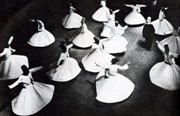
Rumi and his followers, the Mevlevis, completely integrated music and dance in their rituals. According to tradition, Rumi’s companion, goldsmith Salahuddin Zarkub, was working in the goldsmiths’ market in Konya. Rumi passed by and on simply hearing the sound of the goldsmiths’ hammers coming from his workshop began to dance in a whirling movement. Explaining his enthusiasm for dance, Rumi said: “It’s not dance that induces ecstasy, but ecstasy that arouses the dance. The body that moves for pleasure will surely burn in hell. But the hands of Sufis that rise in Sama’ will reach paradise, for we are danced by God the Exalted.” (A Moth to the Flame – The Life of the Sufi Poet Rumi, by Connie Zweig)
When Sufis came to the subcontinent they adopted the local languages in their poetry since poetry and music have played a big part in Indian culture and religion. Thus Sufis also adopted the local music as their mode of spiritual expression. John Baldock notes that: “The outward form belongs to the phenomenal world. As such it is transient, and so is its semblance of stability. The Sufis know that the outward forms taken by their teaching, beliefs and organizations are transient too… The outward form adopted by Sufi teaching therefore changes so that it is presented in such a way that its audience can comprehend it. Sometimes the method appears subtle, sometimes confrontational. It all depends on which method is most appropriate for a particular audience at a particular time. Once it has served its purpose, the outer form adapts itself to suit new circumstances.”
An interesting synthesis of Indian classical form and Sufi music came from the legendary classical singer and composer of music, including one raag, Taansen. Mian Taansen is considered one of the greatest composer and musicians in Indian classical music. Taansen is said to have been influence by the Arabic and Persian music of Mohammed Ghaus of Gwalior, his spiritual guide. The interaction with Ghaus in the Sufi tradition and the earlier training with Swami Haridas in the Bhakti tradition led to a fusion of these streams in the work of Tansen. The word Bhakti in Hinduism is used exclusively to devotion to a particular deity. Certain traditions of Hinduism recommend that a person chose a deity for worship or reverence for one that attracts them most and suits their personality and intellect. The Bhakti tradition also inspired Ghaus, who devotes several chapters to Yoga practices in his text Bahr-ul-Hayat (Ocean of Life). There are many legends attributed to Tansen. According to a local legend, Taansen could bring rain by singing the raga Megh Malhar as well as start a fire with the legendary raga Deepak. And when Taansen would sing for his lover, Tani, the flowers bloomed.
-

Long before 9/11 and the subsequent drumbeat of a war on terror and talk of a clash of civilisations between Islam and…read more →
-

Many people are first introduced to Sufism through the poetry of these Sufi saints that challenges the listener to come…read more →
-

In a dream Sain Zahoor saw a hand beckoning him to a shrine. He could not shake off the dream…read more →






